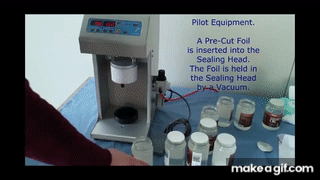Product Sealing Methods
In the past, when it came to container sealing, many manufacturers were faced with the issue of leaky seals, lack of tamper evidence, and problems with keeping their products fresh for consumer use.
 Earlier forms of seal packaging made use of heat shrink bands. These bands were made of PVC plastics which worked for their intended purpose of keeping the contents from leaking. However, these bands were tedious to place onto the container on the part of the manufacturer. For the consumer, the bands served as a barrier between the consumer and the product because of how difficult they were to remove. Additionally, once these bands were removed, they would be very difficult to place back in the container, meaning essentially, they were one-use pieces of plastic and could not adequately keep the product fresh once the container has been opened.
Earlier forms of seal packaging made use of heat shrink bands. These bands were made of PVC plastics which worked for their intended purpose of keeping the contents from leaking. However, these bands were tedious to place onto the container on the part of the manufacturer. For the consumer, the bands served as a barrier between the consumer and the product because of how difficult they were to remove. Additionally, once these bands were removed, they would be very difficult to place back in the container, meaning essentially, they were one-use pieces of plastic and could not adequately keep the product fresh once the container has been opened.
Besides these aspects, another issue brought about by heat shrink bands was that they were not environment-friendly at all. And so, with a growing public outcry against one-use plastics, manufacturers turned to another form of container sealing.
Universal induction foils were introduced particularly for sealing glass packaging. They allowed for the sealing of glass—a feat that proved quite difficult for many manufacturers. These sealed for your protection foils worked well for a while, especially for dry goods and powders. However, as time went by, many have found a big issue with using these types of cap liners when it comes to liquids.
When wet or oily products are placed in these glass containers, the induction foils adhered to the container mouths initially seem to stay. However, over time, the foils tend to lift off of the rim of the container, posing a problem with leakage and issues with the integrity of the product itself. This issue may prove alarming for the consumers themselves, as it can be misconstrued as tampering with the product.
And so, with all of the issues that arose with this more traditional technology, even universal induction foils no longer cut it for the current generation of consumers.
Cap Liners and Induction Seal Packaging
With new technological advancements in cap liner materials and induction sealing, seal packaging is now more efficient and reliable. Cap liners, through the induction sealing process, are able to be processed and adhered to the containers without issue.
In the process of induction sealing, caps come into the production line with the liners placed within them. These liners are placed onto the already-filled containers as they pass down the conveyor line. The containers then pass beneath the induction sealing head which emits an electromagnetic field permeating through the cap and the aluminum foil layer in the liner. This field generates an electric current that, when passed through the sealing film, will melt the film, adhering the liner onto the container’s mouth. The film is then allowed to cool as the container proceeds further down the production line.
This process allows for proper and reliable adherence of the cap liner to the container, serving its function of leak-proofing.
Additionally, the liner cannot be reattached without specialized equipment once someone removes said liner from the mouth of the container. This means that the cap liner serves as a form of tamper evident seal, alerting the consumer of issues with product integrity or external meddling with the contents of the container.
Benefel Pty Ltd. and Adeneli Packaging
Our teams at Benefel Pty Ltd. and Adeneli Packaging can help you with your container sealing needs. Our experts are on standby to take your calls and chats. Whatever product you may have, we have the perfect liner material for you. Product consultation is free and we are happy to develop partnerships with our customers by supplying consumable products that work well with packaging machinery.














Follow Us